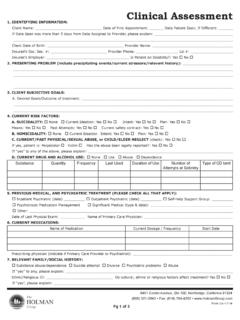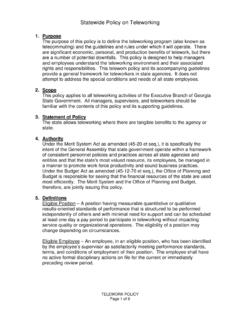Transcription of PCMA Behavioral Crisis Incident Risk Assessment and Root ...
1 PCMA Behavioral Crisis Incident Risk Assessment and Root Cause Analysis checklist Copyright 2011, PCMA, Inc. L. Winston, M. Winston, N. Fleisig Page 1 Instructions: This tool is intended as a guide for more in-depth analysis beyond the simple completion and scoring of the form by one individual. It is recommended that the person using the tool gather information from a variety of sources including any direct observation possible as well as written and verbal reports from direct contact staff, particularly those involved in Crisis events, and other team members. Scores on this tool are not currently correlated with specific levels of risk, but are intended to focus attention on areas in need of more investigation or attention by the organization. It should be noted that potential risks can never be entirely eliminated or perfectly quantified and should always be considered along with potential benefits.
2 Name of Organization:_____ Assessment /Analysis Date(s):_____Person Completing Form:_____ Information Sources:_____ If using this form for analysis of a past event include the following or attach documentation of the Incident being considered: Date of Incident :_____N/A____ Persons Involved and their Roles (consumer, staff member, ):_____ _____N/A____ Short Description of the Incident and Outcomes:_____ _____ _____ _____N/A____ The PCMA BCIRA tool is for use by human services organizations wishing to evaluate their risk of undesired outcomes from Behavioral Crisis events, so as to prevent them from occurring. It is also useful for conducting a proper root-cause analysis after an undesired outcome has occurred. This tool can be used regardless of what Crisis management system is used in the setting or if there is no formal system in place.
3 For updated versions of this tool and for more information on providing safe Crisis prevention and intervention and on reducing risk and injuries, please visit the PCMA website at Version 0311 PCMA Behavioral Crisis Incident Risk Assessment and Root Cause Analysis checklist Copyright 2011, PCMA, Inc. L. Winston, M. Winston, N. Fleisig Page 2 All of the following questions pertain either to individuals in the setting who are subject to physical Crisis management procedures or (if conducting an analysis of a past event), the individual in question. Please check the most appropriate box for each. For each true response, the person completing the form should seek to answer why . 1. Physiological Factors a. Individuals are not given thorough physicals on or before admission with specific attention given to cardiac and pulmonary vulnerabilities.
4 Or/ The individual in question was not given this sort of physical examination on or before admission. True False N/A Note:_____ b. Individuals have a known heart or lung condition. Or/ The individual in question had such a condition. True False N/A Note:_____ c. Individuals may have undiagnosed heart or lung conditions. Or/ The individual in question was later found to have had an undiagnosed heart or lung condition. True False N/A Note:_____ d. Individuals may have medical conditions that can cause pain or discomfort or a greater than normal risk of injury during normal Crisis management procedures. Or/ The individual in question had such a condition. True False N/A Note:_____ PCMA Behavioral Crisis Incident Risk Assessment and Root Cause Analysis checklist Copyright 2011, PCMA, Inc.
5 L. Winston, M. Winston, N. Fleisig Page 3 2. Medication Factors a. Individuals are taking prescribed medication(s) known to cause prolonged QT internals of the heart. Or/ The individual in question was taking one or more of these medications. Risk increases with number of medications taken in combination see attached list. True False N/A Note:_____ b. Individuals are taking prescribed medication(s) known to depress the Central Nervous System. Or/ The individual in question was taking these medications see attached list. True False N/A Note:_____ c. Individuals may receive one or more doses of PRN (emergency) psychoactive medication just before or during a Crisis event. Or/ The individual in question received one or more doses of such medication before or during the event in question. True False N/A Note:_____ d.
6 Individuals are prescribed medication(s) with potential side effects that can contribute to aggressive behavior (increased agitation, increased confusion, physical discomfort, ). Or/ The individual in question was taking one or more of these medications. True False N/A Note:_____ PCMA Behavioral Crisis Incident Risk Assessment and Root Cause Analysis checklist Copyright 2011, PCMA, Inc. L. Winston, M. Winston, N. Fleisig Page 4 3. Programming and Prevention Factors a. There is no (or insufficient) setting-wide, on-going Behavioral programming that focuses on teaching behaviors that help to prevent Crisis (adaptive behaviors/communication skills/replacement behaviors) and provides opportunities, prompting and reinforcement for using these skills. Or/ The individual in question did not receive such programming.
7 True False N/A Note:_____ b. There is no activity schedule in place, there are large gaps in scheduled activities, the students/consumers do not seem interested in scheduled activities, and/or there are few available options for stimulating activities in the setting. Or/ The individual in question had few stimulating scheduled activities or experienced gaps in activities. True False N/A Note:_____ c. Individuals who are subject to one or more Crisis intervention procedures are not immediately referred for complete Behavioral Assessment and the development of individualized behavior plans conducted by qualified individuals. Or/ The individual in question had not received an individual Assessment and behavior plan. True False N/A Note:_____ 4. Staff Training Factors a. Staff members who are likely to be involved in Crisis events (or were involved in the event in question) are not formally trained in Crisis prevention and intervention methods.
8 True False N/A Note:_____ PCMA Behavioral Crisis Incident Risk Assessment and Root Cause Analysis checklist Copyright 2011, PCMA, Inc. L. Winston, M. Winston, N. Fleisig Page 5 b. Crisis prevention and intervention training is not performance-based and/or contains criteria for passing that are subjective, non-standardized or determined by individual instructors. True False N/A Note:_____ c. Training standards are low (too brief, no specified minimum duration (or too short), no specified maximum number of participants (or too many) preventing participants from achieving skill fluency. True False N/A Note:_____ d. Training does not include minimum repetitions of correctly performed skill shown to result in fluency. True False N/A Note:_____ e. Staff members in the setting (or those who were involved in the event in question) have a poor understanding of use and/or release criteria and are inconsistent in applying them to actual Crisis situations.)
9 True False N/A Note:_____ PCMA Behavioral Crisis Incident Risk Assessment and Root Cause Analysis checklist Copyright 2011, PCMA, Inc. L. Winston, M. Winston, N. Fleisig Page 6 5. Staffing and Supervision Related Factors a. Staff members in the setting (or those who were involved in the Incident in question) are not certified or competency trained to implement procedures. True False N/A Note:_____ b. Staff members in the setting often interact with consumers/students in ways that might be characterized as coercive or that involve power struggles . True False N/A Note:_____ c. Staff certifications have lapsed or more than 18 months have passed before refresher training. Or/ This is true of staff members involved in the event in question. True False N/A Note:_____ d.
10 Staff members in the setting (or those involved in the event in question) had prior training in military, martial arts or police methods without more recent training in methods more suited to their current population. True False N/A Note:_____ e. Staff members are not routinely observed performing Crisis procedures by supervisors or otherwise evaluated for on-site, interim refresher training. Or/ On-site refresher training by qualified supervisory or training staff on an as-needed basis is not offered or available. True False N/A Note:_____ PCMA Behavioral Crisis Incident Risk Assessment and Root Cause Analysis checklist Copyright 2011, PCMA, Inc. L. Winston, M. Winston, N. Fleisig Page 7 f. There are factors that discourage staff members from fully and accurately reporting events and may encourage invention or modification of procedures, such as: Crisis definitions with loopholes that allow certain events to go unreported, hands-off policies without sufficient alternatives, and undesired consequences to staff members for reporting and/or intervening.





